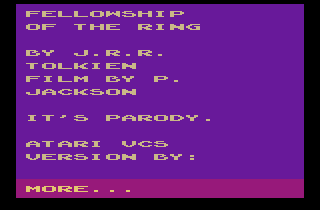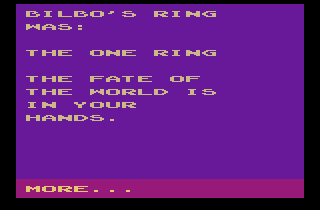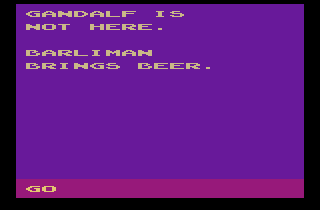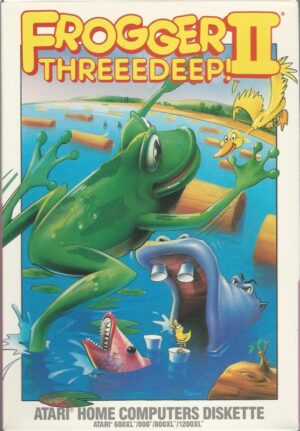Retro Replay Review
Gameplay
The Lord of the Rings: The Fellowship of the Ring transforms Tolkien’s epic narrative into a tightly focused interactive fiction experience. Players navigate the plot through simple joystick-driven selections, choosing actions and dialogue that guide Frodo and his companions from the Shire toward Mordor. While the control scheme is minimalistic, it effectively captures the decision-making spirit of classic text adventures, offering multiple choice prompts that shape the party’s journey.
(HEY YOU!! We hope you enjoy! We try not to run ads. So basically, this is a very expensive hobby running this site. Please consider joining us for updates, forums, and more. Network w/ us to make some cash or friends while retro gaming, and you can win some free retro games for posting. Okay, carry on 👍)
The game’s pacing reflects the constraints of the Interactive Fiction IntroComp format, condensing complex events into a series of critical decision points. Key moments—such as meeting Gandalf in Bree or forming the Fellowship in Rivendell—are presented as choice-driven scenes where the stakes feel high yet manageable. Though the scope is narrower than a full parser-based text adventure, each selection carries weight, encouraging careful consideration and occasional replay to discover alternative outcomes.
Exploration in The Fellowship of the Ring is primarily narrative rather than spatial. Instead of freely roaming a detailed map, players advance by selecting from presented actions at each story beat. This structure streamlines the experience, ensuring the focus remains firmly on the plot and character interactions. While some interactive fiction veterans may miss deeper puzzle-solving elements, newcomers will appreciate the clarity and directness of the gameplay flow.
Graphics
As an interactive fiction title built on the Dark Mage engine, The Fellowship of the Ring places emphasis on text over visuals. The game features a stark, text-centric interface that displays prompts and narrative passages against a simple backdrop. While there are no illustrated scenes or character sprites, the clean presentation allows the player’s imagination to flourish, evoking Middle-earth through descriptive writing rather than pixel art.
Customization of the text window—such as scroll speed and font size—is minimal but sufficient for comfortable reading. The absence of elaborate graphical assets keeps system requirements low and places the entire storytelling burden on well-crafted prose. This design choice reinforces the feel of reading an interactive book, with each line of text carrying the weight of Tolkien’s legendary world.
Occasional small icons or symbols may accompany menu options, but these are strictly functional, guiding selection rather than offering cinematic flair. For genre purists who expect rich visuals, this might feel underwhelming. However, those who appreciate classic text adventures will find the understated interface refreshingly uncluttered and perfectly in tune with the game’s narrative-driven ambitions.
Story
Drawing directly from the first volume of The Lord of the Rings trilogy, this game delivers a condensed yet faithful retelling of the Fellowship’s formation. Iconic locations such as the Prancing Pony, Rivendell, and the Mines of Moria appear in streamlined form, preserving key plot beats while omitting some of the denser subplots. For newcomers, it serves as an accessible introduction, while longtime fans will recognize and relish each major event.
The narrative is presented in bite-sized passages that capture the essence of Tolkien’s prose without overwhelming the player. Each paragraph offers just enough detail to evoke atmosphere—be it the shadowy corridors of Moria or the tranquil gardens of Rivendell—while interactive choices allow the player to influence minor variations in dialogue and action. The result is a dynamic re-creation of the Fellowship’s story that balances fidelity with playability.
Characterization leans on familiar archetypes, from Frodo’s quiet bravery to Gandalf’s guiding wisdom. Although the game’s brevity means that some companions receive less individual attention, pivotal interactions—such as Gimli and Legolas bonding or Boromir’s inner conflict—still resonate. This ensures the Party feels believable and their shared quest retains its emotional impact, despite the limitations imposed by the competition’s entry rules.
Overall Experience
The Lord of the Rings: The Fellowship of the Ring offers a compelling slice of Tolkien’s masterpiece, tailored for interactive fiction enthusiasts and newcomers alike. Its concise structure and intuitive selection-based gameplay make it approachable, while the rich source material guarantees a sense of grand adventure. Although it lacks graphical extravagance, the game compensates with evocative writing and meaningful decision points.
Players seeking a deep puzzle-driven text adventure may find the challenges lighter than expected, but the emphasis on narrative momentum keeps the experience engaging from start to finish. Replay value emerges in revisiting key decisions—choosing different paths in Moria, or testing alternative dialogue options in Rivendell—to see how small changes ripple through the Fellowship’s journey.
In sum, Adam Thornton’s 2002 IntroComp entry stands as a testament to the enduring appeal of text-based storytelling. It captures the spirit of Tolkien’s world, transforming it into an interactive narrative that fits comfortably within a modern indie gaming library. For anyone curious about Middle-earth or the roots of interactive fiction, The Fellowship of the Ring is a rewarding experience that pays homage to both its literary inspiration and the tradition of choice-driven gameplay.
 Retro Replay Retro Replay gaming reviews, news, emulation, geek stuff and more!
Retro Replay Retro Replay gaming reviews, news, emulation, geek stuff and more!







Reviews
There are no reviews yet.